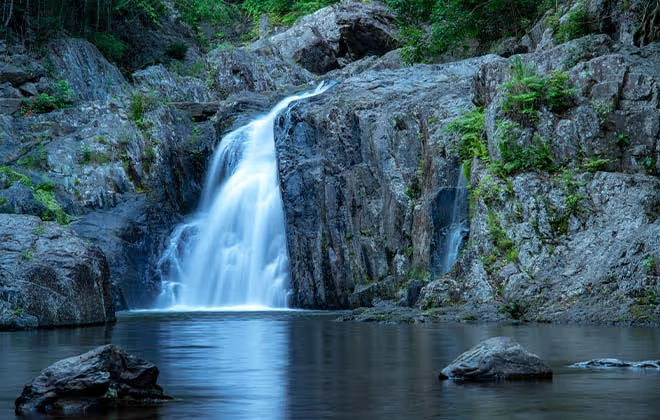Tour destinations
Responsible tourism


Located a short drive northwest of Cairns, in tropical North Queensland, Barron Gorge National Park extends from the coastal lowlands to the elevated regions of the Atherton Tableland. It’s a magnificent landscape of steep gorges, rugged peaks and lush rainforests often shrouded in mist. Barron Falls is a major feature of the park and changes from a trickle to a torrent depending on rainfall.
Barron Gorge National Park has become one of Australia’s most popular national parks due to its accessibility, a diverse range of walking tracks and recreational opportunities, stunning scenery and an amazing array of tropical plants and interesting wildlife. The park is managed by the Traditional Owners, the Djabugay people, and Queensland Parks and Wildlife Service and is part of the Wet Tropics World Heritage Area.

Take the first step toward your next adventure—explore our tours or get a free brochure sent to your inbox.
The Barron River is a dominant feature of Barron Gorge National Park. Emerging from the rainforests, the river winds 60 kilometres across the Atherton Tablelands through one of Australia's highest rainforest regions, to the Barron Gorge. The river falls 250 metres onto the narrow coastal lowlands, flowing into the Coral Sea.
During the wet season (December to March), rain and floodwaters regularly create a spectacular sight at Barron Falls, one of the most popular tourist spots in the park.

.avif)
Although renowned for its dense, tropical rainforests, the park comprises a diverse population of plant life including open woodlands with groves of she-oaks, grassland patches and upland heath. The Barron Gorge National Park is a natural corridor for wildlife like striped possums, long-tailed pygmy possums, Lumholtz’s tree kangaroos, musky rat kangaroos and spotted-tailed quolls. Insectivorous bats, the distinctive spectacled flying fox, platypus, and short-beaked echidna are all part of this ancient landscape.
Book a tour and come walk this special land with us.
Barron Gorge National Park is within the Wet Tropics World Heritage Area (WTWHA) and extends 450 kilometres from Cooktown to Townsville. The area began to form around 400 million years ago, when Australia was part of the supercontinent, Gondwana. Covering almost 900,000 hectares, the vegetation is predominantly tropical rainforest but includes wetlands, open eucalypt, and mangrove forests.
Barron Gorge is a place of great cultural significance for Traditional Owners, the Djabugay who maintain a close spiritual connection to the area. Before Europeans arrived, Djabugay walked the land, carving trails from the coast to higher ground to trade, gather food and visit ceremonial sites. These historic trails now form part of the Barron Gorge network of both short and long-distance walking tracks.
The park is a bird watchers’ paradise with vibrant rainbow and scaly-breasted lorikeets, emerald doves and the elusive wompoo fruit-dove. Australian brush turkeys are plentiful, along with the orange-footed scrub fowl. The impressive, endangered southern cassowary makes its home in the forest along with the brilliant blue Ulysses butterfly and vivid green Cairns birdwing butterfly. Numerous varieties of reptiles, fish, and frogs all play their role in this delicate ecosystem.
Our team is always happy to help if you have any questions about us or our tours. Fill out our form and we will get back to you soon.